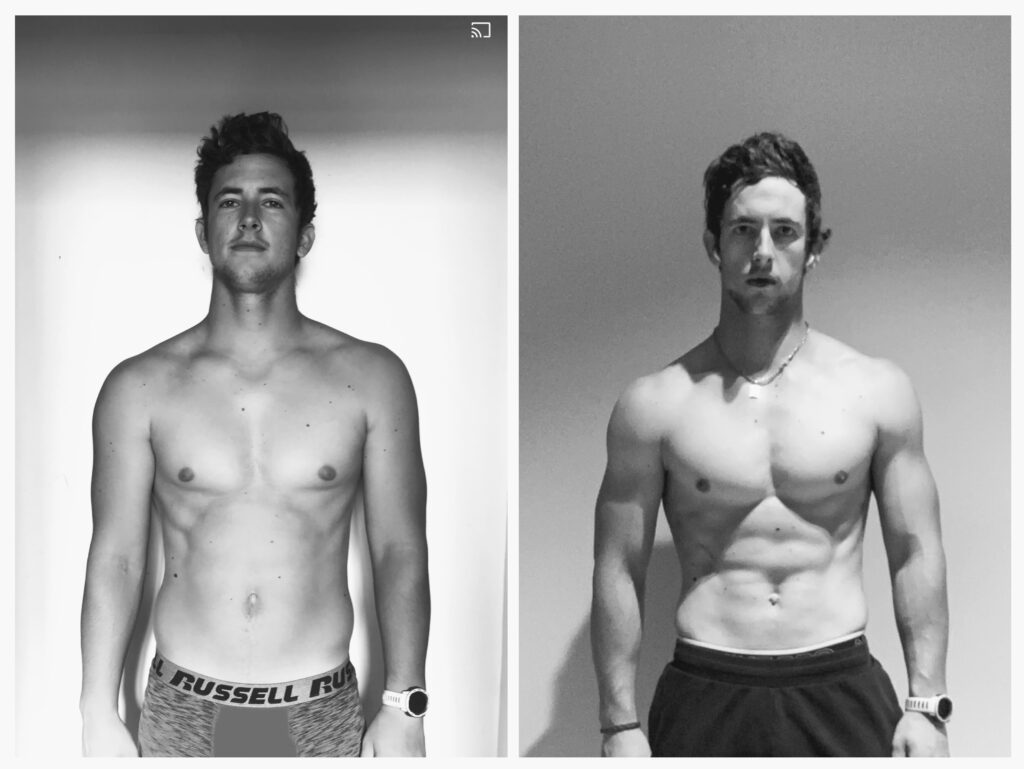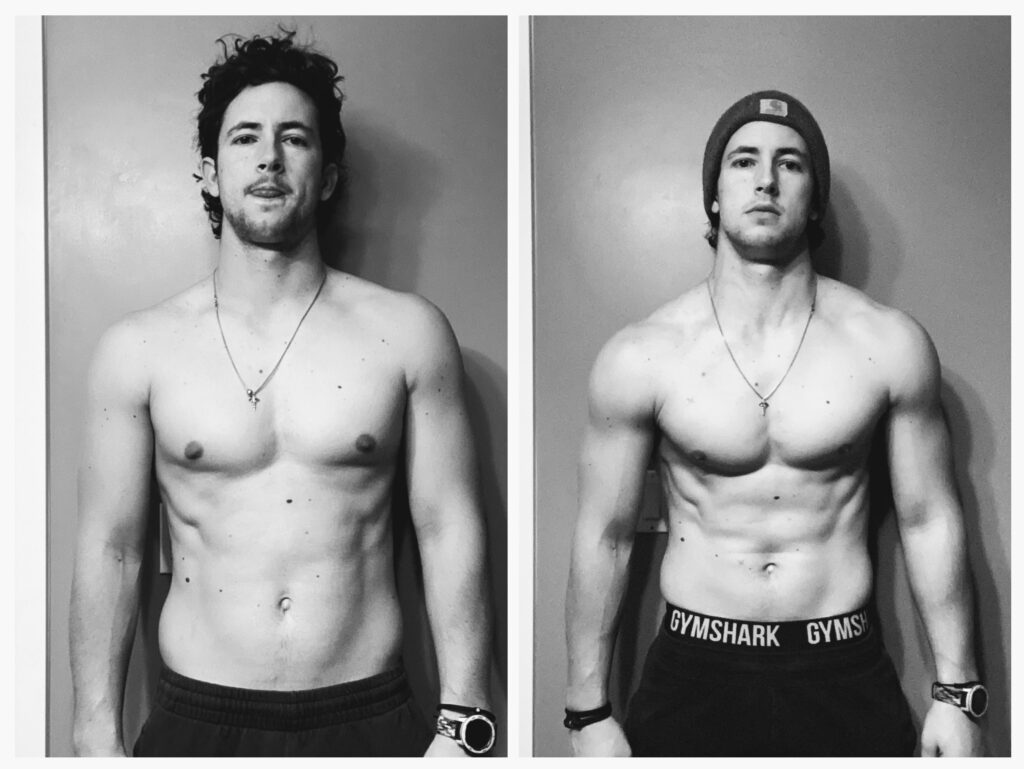I’ve been pretty active my whole life but have upped my fitness game in the past few years, and if I could meet my past self, I’d probably slap the protein shake right out of his hands. The things I used to do? Hilarious. But we all start somewhere, and for me, it began with a challenge from my cousin: get a six-pack or the other would buy you a swimsuit of his choice, (not likely to be a pleasant experience).
At the time, I had no idea what I was doing. My approach? Starve myself and hope for the best. I cut calories way too fast, dropping from around 16-20% body fat to 11.9%. Success, right? Nope. My metabolism tanked, and I hit a plateau so hard it could’ve been a brick wall. Luckily 12% was the goal so my pride was spared.
This was my first real lesson in fat loss: the body fights back. It’s called metabolic adaptation, and I was experiencing it in full force. I was eating within a 4 hour window each day, mostly protein, and feeling miserable. If you’ve tried intermittent fasting you’ll understand. It turns out when you cut calories too aggressively, your body doesn’t just sit back and let it happen—it slows your metabolism to conserve energy. (Rosenbaum & Leibel, 2010)
Bugatti vs. Prius
Your metabolism is like the fuel efficiency of a car. If you had the metabolism of a Bugatti Veyron, you’d burn through calories like a 16-cylinder 1,200 horse power engine guzzling gas—requiring a massive intake just to function and can travel about 10 miles for every gallon of gas. But if you’ve got enough to spend $3,000,0000 on a sports car you probably not to worried about gas prices. But most of us are more like a Prius—efficient, built for endurance, and unfortunately, very good at storing energy (fat) for future use.
This efficiency is great for survival, but terrible for weight loss. Evolution didn’t design us for an era of fast food, ultra-processed snacks, and calorie overload. Your body is wired to crave high-calorie foods and store fat because, historically, food wasn’t always available.
The Science of Excess Body Fat and Hormonal Resistance
Carrying excess body fat isn’t just about aesthetics—it fundamentally alters the way your body functions. Your body fat releases hormones… ya read that again. Your body fat releases hormones. More fat means higher hormone production. The more fat you accumulate, the more likely you are to develop leptin resistance and insulin resistance—two metabolic shifts that make weight loss even harder.
- Leptin resistance: Normally, leptin signals your brain that you’re full and don’t need more food. However, when you have excess body fat, your leptin levels are constantly elevated, and your brain becomes desensitized to the signal. (Heymsfield et al., 2002) This means you stay hungry even when you’ve eaten enough.
- Insulin resistance: Insulin’s job is to regulate blood sugar by shuttling nutrients into your cells for energy. With excess fat, your cells become less responsive to insulin, leading to increased fat storage and making weight loss even more difficult. (Shulman, 2000)
These two factors create a cycle—your body craves more food, stores more fat, and makes it harder to lose weight. This is why the longer you stay overweight, the more effort it takes to reverse it.
It’s Not Just About Appearance
Now before you go all “body positivity” on me let me just say if your happy where your at I have no problems with that. However, I think everyone should at least get in incredible shape once in their life and then decide what they want to do from there. Don’t tell me you’re happy where you’re at having never been in shape before, odds are you just don’t have the information or discipline to get there even if you “wanted” to. If you disagree tell it to the almost 300,000 bariatric (overweight) surgeries performed annually that if there was a button to magically be in great shape you wouldn’t press it. I’ll wait.
For years, I saw the fitness industry as purely about aesthetics, but over time, I realized that how you feel, function, and move is just as important it’s just not as marketable. That being said, if you’re already putting effort into how you present yourself—whether that’s wearing nice clothes, styling your hair, or looking put together—why not extend that effort to your physique?
Looking fit might not be everything, but it does influence how you’re perceived. The Halo Effect is real—people subconsciously associate a lean, muscular physique with discipline, confidence, and success. While that shouldn’t be the only reason to get in shape, it’s an undeniable factor in how we navigate the world.
The Role of Dopamine and Food Addiction
Dopamine, the “feel-good” hormone, plays a major role in why we crave and overeat highly processed foods. Just like other addictive substances, these foods trigger a dopamine release, reinforcing behaviors that make us eat more. The book Ultra-Processed People goes into detail about how the food industry engineers foods to be hyper-palatable, making it easier to consume massive amounts before your body realizes it’s full.
Back in the day, bread was tough and required soaking in milk or water to eat. Now, you can practically eat a Big Mac with a spoon. The softness, the ease of chewing, the perfect balance of salt, sugar, and fat—it’s all designed to make you eat more.
So “listen to your body” may have worked in the past but unfortunately that time has come and gone.
Learning to Do It Right
After that initial crash-and-burn, I started getting serious about learning how fat loss actually works. I experimented with different diets, training styles, and calorie tracking methods. Eventually, I did a deep dive into meticulous calorie counting, consistent weigh-ins, and monitoring my body composition. Everything was documented in an excel sheet every day. The result? I got down to 7.9% body fat. Now am I gonna win any body building competitions with that? Certainly not but that was never the goal.
The journey wasn’t just about numbers. I learned a lot about myself in the process. I became the guy who weighed his food, who said “no thank you” when offered desert, and who treated every bite of food like it was a financial transaction. It wasn’t always fun, but it gave me an appreciation for the science of weight loss. Taught me added discipline, impulse control and mental stamina, and more respect for people with impressive physiques. You can say its because they were born that way, and I’m not saying you’re 100% wrong but I’ve been there and I said that, and turns out I just didn’t know.

The Reality of Maintaining Low Body Fat
I had heard that getting a six pack is great but it is not sustainable. Even body builders have off seasons. To maintain a six pack you would be limited to eating chicken and broccoli and starving all the time. Regardless I wanted to try it, I wanted to have “been there, done that, and got the t-shirt” at least once. And I also wanted to know if they were right.
Losing the weight was just the beginning. Maintaining my new body composition required just as much effort, if not more. Research suggests that once you reach your goal, you need to maintain it for at least a year to establish a new metabolic set point. (Dulloo & Montani, 2015) Your body doesn’t just instantly accept its new state—it takes time to adjust. This means you’ll be hungry for a while!
The reality; I only had to hyperfocus on calories for a about 3 months of that year. The habits I built during my cut carried over. I naturally ate cleaner. I instinctively portioned my meals better. As I gradually reintroduced calories back into my diet through a process called reverse dieting I wasn’t starving all the time. I could still indulge on weekends. Turns out, your body adapts to a new normal.
I developed what I call an “internal calorie budget.” Just like you know roughly how much you can spend in a month without checking your bank account every day, I knew how much I could eat. If I started to gain weight, I tightened things up. If I lost too much, I ate a little more.
This is Set-Point Theory in action, which suggests that your body has a preferred weight range that it defends through metabolic and hormonal regulation. (Müller et al., 2010) If you slowly lose weight and maintain it long enough, your body will adjust, making it easier to stay lean without constant effort.
The Final Experiment: Bulking and Cutting Like a Pro
After maintaining my lean physique for a year, I decided to try a “bulk.” I gained 20 pounds over four months, then cut back down over six weeks. The difference? This time, my metabolism was working for me. I wasn’t starving, my strength was up, and fat loss was happening without the misery I’d experienced before. That’s not to say it was effortless.
Remember my first attempt at intermittent fasting, where I starved myself and plateaued at 11.9%? This time, I had already gotten down to 10% in a month and a half, eating more than I did in my first go-around. This is the benefit of having your body on your side.
But I wouldn’t be here if I hadn’t gone to war with it first. There were many times where I went to bed hungry. Many irritable days, dealing with a headache as my hormones stubbornly fought back. Many times I looked at the scale after a hard long week and saw no results. Many times thinking that a hamburger and fries would solve my problems. And many times I had to tell me my body to just deal with it because to quote David Goggins “I don’t stop when I’m tired, I stop when I’m done.”

So, if you’re stuck in the cycle of crash diets and frustration, trust the process, play the long game, and give your body the credit it deserves.

2 responses to “Weight Loss: Why You Must Go To War With Yourself”
Dank memes dude! Thoroughly enjoyed the read, especially the mpg analogy haha keep up the good work man and once this semester is over you best believe I’ll be hitting the gym harder than my metabolism hitting a wall after In n out. 💪 stay hard
thanks man, “stay hard”